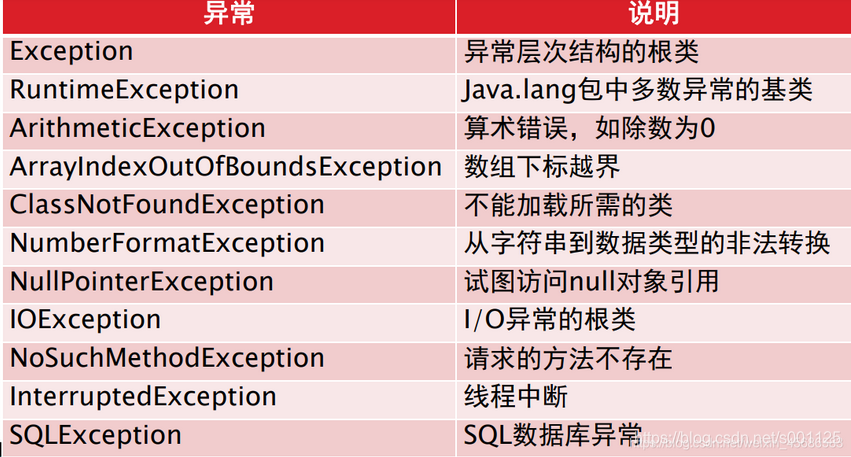异常
异常(exception):是在运行过程中代码序列中产生一种例外情况。
异常的类型有

1、try-catch结构
使用 try 和 catch 关键字可以捕获异常。try/catch 代码块放在异常可能发生的地方。
try/catch代码块中的代码称为保护代码,使用 try/catch 的语法如下:
try
{
// 程序代码
}catch(ExceptionName e1)
{
//Catch 块
}
例如
public static void main(String[] args) {
try{
int num = 5/0;
System.out.println(num);
}catch (ArithmeticException e){
System.out.println("除数不能为零");
}finally {
System.out.println("回收代码资源");
}
try{
String string = null;
System.out.println(string.length());
}catch (NullPointerException e){
System.out.println("数值不能为空");
}finally {
System.out.println("回收代码资源");
}
System.out.println("程序继续执行");
}
2、多重try-catch结构
一个 try 代码块后面跟随多个 catch 代码块的情况就叫多重捕获。
try{
// 程序代码
}catch(异常类型1 异常的变量名1){
// 程序代码
}catch(异常类型2 异常的变量名2){
// 程序代码
}catch(异常类型3 异常的变量名3){
// 程序代码
}
例如
try {
file = new FileInputStream(fileName);
x = (byte) file.read();
} catch(FileNotFoundException f) {
// Not valid!
f.printStackTrace();
return -1;
} catch(IOException i) {
i.printStackTrace();
return -1;
}
3、throws/throw 关键字
如果一个方法没有捕获到一个检查性异常,那么该方法必须使用 throws 关键字来声明。throws 关键字放在方法签名的尾部。
也可以使用 throw 关键字抛出一个异常,无论它是新实例化的还是刚捕获到的。
例如
import java.io.*;
public class className
{
public void deposit(double amount) throws RemoteException
{
// Method implementation
throw new RemoteException();
}
//Remainder of class definition
}
import java.io.*;
public class className
{
public void withdraw(double amount) throws RemoteException,
InsufficientFundsException
{
// Method implementation
}
//Remainder of class definition
}
4、finally关键字
finally 关键字用来创建在 try 代码块后面执行的代码块。
无论是否发生异常,finally 代码块中的代码总会被执行。
在 finally 代码块中,可以运行清理类型等收尾善后性质的语句。
public class ExcepTest{
public static void main(String args[]){
int a[] = new int[2];
try{
System.out.println("Access element three :" + a[3]);
}catch(ArrayIndexOutOfBoundsException e){
System.out.println("Exception thrown :" + e);
}
finally{
a[0] = 6;
System.out.println("First element value: " +a[0]);
System.out.println("The finally statement is executed");
}
}
}
finally 可以把它看成为回收资源。
5、总结
- 运行时发生的错误称为异常;
- Java使用try,catch,throw,throws和finally来处理Java异常;
- 被监控的代码写在try块中,用来捕获和处理异常的代码写在catch块中,finally中放置必须要执行的代码;
- 要手动引发异常,可以使用关键字throw。抛到方法外部的任何异常都必须用throws子句指定。